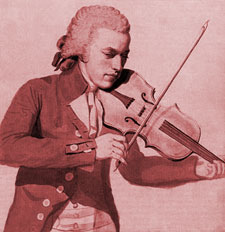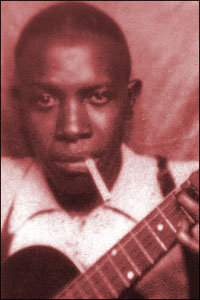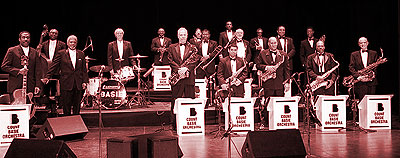
|
|||
|
|||
| Home |
| Gallery |
| Culture/ Technology |
| Fiction |
| Music |
| Poetry |
| Theater |
| What's New |
| About/Contact |
| Archive |
|
The universality of the blues Published July 2006 If one were to argue that baroque, classical, romantic or opera, as products of European culture, could only be played with authenticity by whites and that Yet such arguments are often made – and rarely challenged – with regard to whites playing the blues. The fact that such statements are not only accepted, but often viewed as friendly toward the African-American culture that created the blues, shows that even aficionados of the blues reflexively accept the dominant culture's assignation of second-class status to products of African-American society. For, if we examine this issue closely, it is only too clear that by judging the blues on cultural rather than artistic standards, we deny the universality of the blues. In so doing, we differentiate the blues from other, mostly European, art forms for which we accept the fact that any individual, no matter her/his cultural background, is able to express her/himself fully and legitimately through said art form. And since the blues is, along with jazz, gospel and rap, one of the most visible, and thus most important, art forms to have been created by African-American society, we implicitly indicate our feelings toward African-American culture in general through our treatment of the blues. Any attempt to project cultural limitations on blues performances is dependent on acceptance of a "high art" / "folk art" dichotomy. The term "high art," generally applied to European modes of creative expression, carries with it a connotation of universality, of an artistic expression unconstrained by the individual artist's cultural background. "Folk art" is a pejorative term, conveying images of cultural immaturity and a sense of primitiveness that permanently weds the form to cultural, rather than artistic, standards. We see this often when discussing non-Western art forms. The musics of Native Americans, Africans and South Pacific islanders, among others, are generally discussed and studied within the framework of their social role or within a strictly religious envelope. Yet study of the music of Johann Sebastian Bach, most of which was written for the Christian church where he served as music director, is rarely subject to such intellectual blinders. But as linguist/critic Jerome Rothenberg has amply demonstrated, the differentiation of art forms into "high" and "folk" strata is not only arbitrary, but entirely a product of Western prejudices. There quite simply is no objective standard by which opera or flamenco is any more capable of expressing universal human truths than Balinese poetry, plains Indians dance or the blues.
Too, the work of American composers such as Aaron Copland and George Gershwin (and Ellington, and more recently Marsalis) have shown that a "folk" form created by American blacks is every bit as capable of high-society formality as any of the European symphonic forms – which were, after all, often derived from European "folk" forms such as waltzes, polkas and mazurkas themselves born of rural environments every bit as rough-hewn as those that birthed the blues in the United States. It should be clear that if we accept the blues as music, as an art form, and not as a cultural phenomenon, then it is impossible to dismiss a blues performer simply because they are white. To be sure, we must use caution in acknowledging the role of whites in the blues. One area of concern must be the artistic integrity of the music itself. Many white musicians hailed by an unfamiliar mainstream press as "blues" artists in fact play rock that sounds bluesy. But their music can easily be so identified structurally and stylistically. Examples might include, but would not be limited to, much of the recorded output of musicians such as Eric Clapton, Johnny Winter, George Thorogood and the late Stevie Ray Vaughan. But what of a Tracy Nelson? Or Charlie Musselwhite? Anson Funderburgh, John Hammond or Rory Block? Certainly the music they have created and performed is as much a part of the contemporary blues scene as the music of their African-American contemporaries whose music is in many cases far less immersed in the blues, yet who are generally embraced even by the most hardcore blues fans and writers. Robert Cray and Koko Taylor both describe their own music not as pure blues, but as a blues-rock hybrid – although both are almost universally acclaimed as "blues" musicians. Surely these examples point out the folly, the arbitrariness of attempting to classify music based on the ethnicity or cultural background of a performer rather than through a careful analysis of their music. Yet there is also danger in embracing whites as the legitimate blues artists many of them are – and this is the very real possibility that the white-dominated media will focus undue attention on the white artists, ignoring African-American blues artists. This is something we saw in the 1950s and '60s when white jazz musicians first began to be taken seriously in that form, to the point that black musicians were often overlooked by the press and record companies. For every white artist like Stan Getz, Dave Brubeck and Chet Baker whose talent was rightly celebrated and embraced, there was a black artist like Billy Eckstine, Sonny Stitt or Lee Morgan who could never get their due. Was the color of their skin the reason for their relative lack of commercial success? We do not yet live in a colorblind society, and these are fair and important questions to consider.
We do black blues musicians no favor ensuring they get proper acknowledgement and remuneration for their talents if we do so only by imposing second-class citizenship on one of the most visible products of African-American culture. To continue down that path is to continue to deny the readily apparent universality of the blues, and to continue to pretend that this expressive, graceful form is somehow less than its European counterparts. To claim that whites cannot legitimately play the blues with all the passion, commitment and, yes, beauty of the African-Americans who first developed it a century ago is to deny the spirit of the blues itself. Just as Europeans invented the symphony, but we now accept classical musicians from China to Africa – so, too, the creation of African-Americans, the blues, now belongs to all the world. Published July 2006 |

 performances by non-whites such as Wynton Marsalis or Kathleen Battle were, by their very nature, lesser and examples of cultural plagiarism, one would be – correctly, I think most of us would agree – dismissed as a bigot.
performances by non-whites such as Wynton Marsalis or Kathleen Battle were, by their very nature, lesser and examples of cultural plagiarism, one would be – correctly, I think most of us would agree – dismissed as a bigot. If Rothenberg's rather esoteric linguistic theories are not convincing enough, then the example of jazz/blues bands such as those of Edward "Duke" Ellington, William "Count" Basie, Benny Goodman and many others offer strong examples of the blues being transported to settings traditionally reserved for the so-called "high" or classical forms. From Carnegie Hall to opera houses and symphony halls the world over, Ellington, Basie and others put on black tie and tails and took their blues-birthed music to the most socially exclusive environments mankind has ever known.
If Rothenberg's rather esoteric linguistic theories are not convincing enough, then the example of jazz/blues bands such as those of Edward "Duke" Ellington, William "Count" Basie, Benny Goodman and many others offer strong examples of the blues being transported to settings traditionally reserved for the so-called "high" or classical forms. From Carnegie Hall to opera houses and symphony halls the world over, Ellington, Basie and others put on black tie and tails and took their blues-birthed music to the most socially exclusive environments mankind has ever known. Again, though, the best way to deal with this is not by using arbitrary and racist criteria to define some false standard of "legitimacy," but by a careful, diligent analysis not only of the music, but of the writing about and marketing and selling of the music. Through devotion to serious critical analysis and a willingness (and committment) to judging performers by their artistry, I believe it is possible to shed the racism inherent to a blacks-only blues purism and instead embrace blues as the mature art form it is, one through which anyone with the requisite talent, training and hard work can learn to express themselves.
Again, though, the best way to deal with this is not by using arbitrary and racist criteria to define some false standard of "legitimacy," but by a careful, diligent analysis not only of the music, but of the writing about and marketing and selling of the music. Through devotion to serious critical analysis and a willingness (and committment) to judging performers by their artistry, I believe it is possible to shed the racism inherent to a blacks-only blues purism and instead embrace blues as the mature art form it is, one through which anyone with the requisite talent, training and hard work can learn to express themselves.